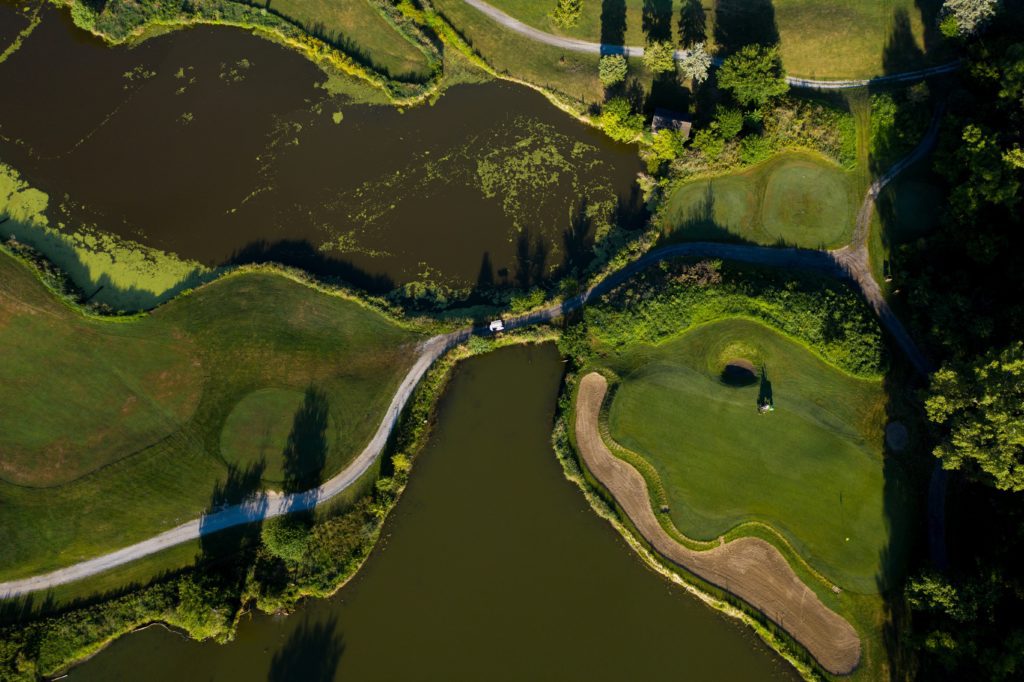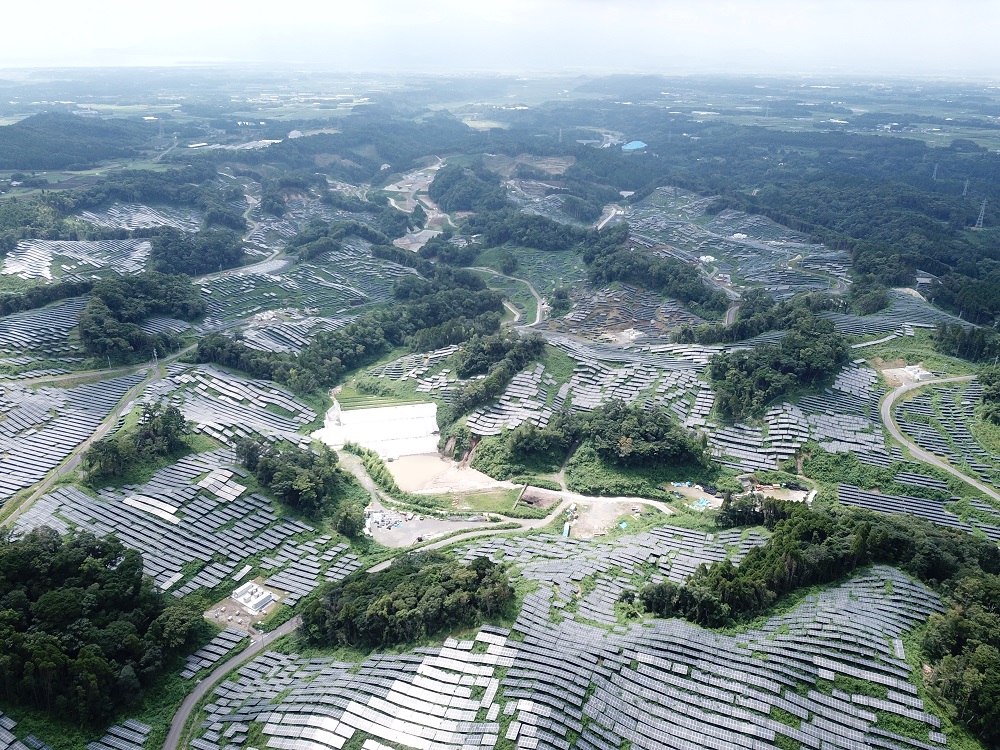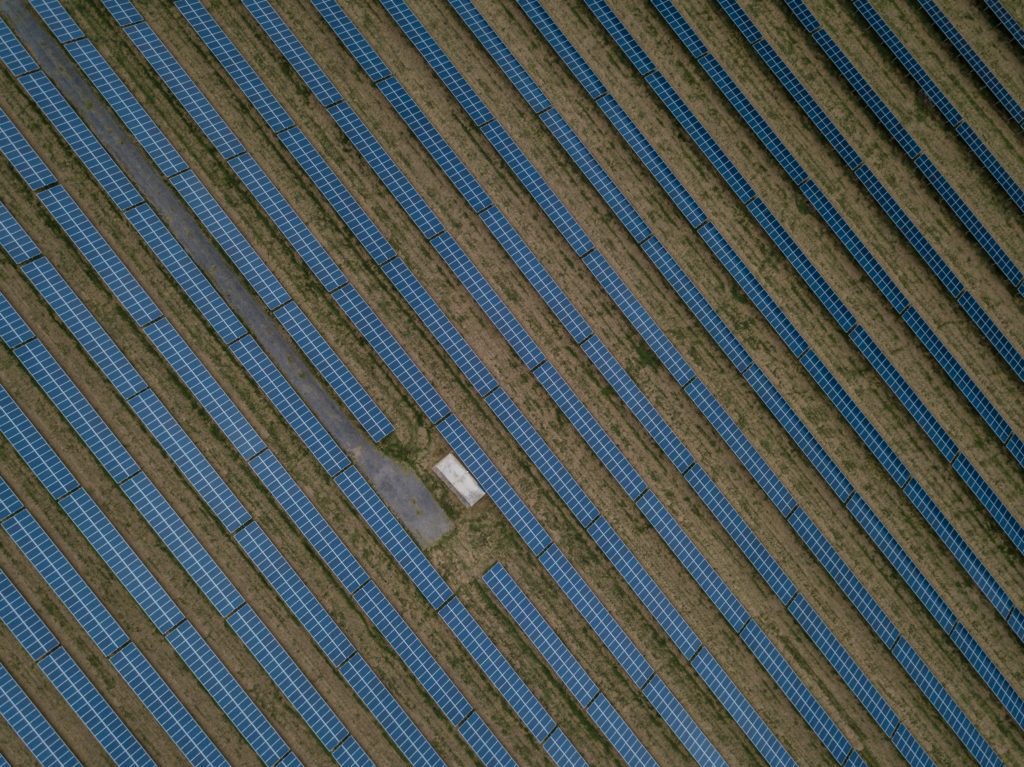
Golf Courses, Potential Solar Farms
Golf Courses Potential Solar Farms: Golf courses account for 2 million acres of US land.1 There are about 16,000 courses in the US2 and “most golf courses are spread across 110 to 190 acres.”3 Golf is on the decline, with a 22% loss of golfers (6.8 million) from 2003 to 20184, and more than 800 golf courses have shut down in the US as people between 18 and 30 “have a lack of interest in playing the game.”5
Environmental Concerns
Courses consume large amounts of water which, especially, is a concern in the desert and drought-facing areas. For example, Palm Springs has 57 golf courses and each of them uses the amount of water “an American family of four uses in four years”6 each day. California has 1,140 courses and just reducing water usage by a quarter would save 37 million gallons of water per day.7 US courses are using about “2.08 billion gallons of water per day for irrigation…about 130,000 gallons per day per course, according to the golf industry.7 However, Audubon International estimates “that the average American course uses 312,000 gallons per day.”6
“a toxic assortment of synthetic fertilizers, herbicides, fungicides, and insecticides…can harm golf course workers and players, drift onto neighboring properties, seep into ground or well water, and devastate local wildlife.”8
Continued
Pesticide and fertilizer use in golf courses is another area of concern. Like copious amounts of water, they’re used to keep up with the green, pristine aesthetic of courses. Nitrates can contaminate groundwater and is a health hazard as people consume it through their water9 and through the food chain.9 Nitrogen and phosphorus pollute surface waters and can lead to eutrophication – the process by which excessive nutrients from land runoff lead to increased plant and algae (blooms) growth in estuaries and coastal waters, then leading to “low-oxygen (hypoxic) waters that can kill fish and seagrass and reduce essential fish habitats,”10 resulting in large amounts of carbon dioxide in the water after decomposition of the surplus algae and plants. Plus erosion leading to sedimentation, “primarily a concern during construction, and can cause damage to streams and lakes”9 and can carry pesticides, fertilizers, and other nutrients into waterways.
“..there is growing acknowledgment of the damage golf courses can inflict by changing existing open space ecology; denigrating wetlands, sensitive aquifers or habitat; or contributing to runoff carrying pesticides, fungicides, herbicides and fertilizers.”4
However golf courses aren’t all bad, there is evidence suggesting golf courses can maintain green-area habitats and biodiversity in urban areas11 and can be used as “wildlife sanctuaries”9 in certain situations. Of course, if the golf course is near or in “wetlands, forests, and other environmentally sensitive areas”9, there is more of a threat posed to land and habitat loss (wildlife fragmentation, degradation of natural areas, natural plant community replacement with intensively managed landscapes and non-native plants12).
Repurposing Golf Courses Into Potential Solar Farms

Repurposing golf courses into solar farms have come to fruition in Japan. Kyocera is “a multinational electronics manufacturer”14 which has made more than 60 solar power plants in Japan. The Kyocera’s joint-venture solar plant, from the picture above, opened in 2020.15 It’s a 100 MW plant that’s “expected to generate some 117,000 MWh per year.”13
The plant goes “over an area, originally designed for a golf course, of almost 2,000,000 square meters, between Kanoya and Osaki. This is almost equivalent to the size of the Principality of Monaco.”15
Another Kyocera solar power plant located on an abandoned golf course started operation in 2018 in Yonago City.16 The plant’s capacity is 29.2 MW and is expected to produce 36,080 MWh per year which is “enough electricity to power approximately 12,000 typical households.”16 Kyocera also finished construction on the largest Japanese floating solar farm in 2018.14
Some motivation behind Japan’s renewable energy projects stems from looking for “alternatives to nuclear energy after the Fukushima disaster of 2011.”14

Other, more common forms of golf course repurposing in the US, include the creation of affordable housing, parks, “shops, community centers, libraries, schools, and all sorts of other buildings that could help rebuild a long-lost sense of community”17 in urban, suburban areas. However, there still are a few plans to turn golf courses into solar farms in the US. Duke Energy Renewables had purchased a 24.9 MW solar project, “located on the site of the former Tallgrass Golf Course in Brookhaven,”18 New York. It’s estimated to produce 1 million MWh of energy in its lifetime and “displace 29,000 tons of greenhouse gas emissions annually.”19
As of this year, there has been a proposal to turn Cape Cod Country Club’s golf course in Falmouth, Massachusetts, into a solar farm. The Club had been looking for new uses since 2019, and if permitting goes as planned, 80 acres of the golf courses’ 150 acres would be used to produce 27-30 MW.20
The Pine Brook Community Solar Farm is currently under development in Gloversville. New York. It would use 32 acres of the former Pine Brook Golf Course21 and produce enough energy to power 1,225 homes.22 With a capacity of 7.5MWp, the farm will “absorb 310,000 pounds of carbon dioxide each year.”23 But that’s not all Eden Renewables wants to do with their 57 acres of the original golf course, the company also wants to use the area for supporting bees and pollinators with wildflower meadow habitats23 which will provide “pollination services for local farmers, and produce local honey.”22 Alongside promoting biodiversity the site will have recreational areas and be used as an educational resource for local schools.22

Learn More
Read more about the solar industry: https://www.seia.org/solar-industry-research-data
Read more about solar farms: https://chariotenergy.com/chariot-university/solar-farms/
Read more about solar farms around the world: https://www.nbcnews.com/mach/science/supersized-solar-farms-are-sprouting-around-world-maybe-space-too-ncna901666
Read more about abandoned golf courses: https://www.businessinsider.com/inside-two-abandoned-golf-courses-2017-6
Sources
- Merrill, Dave, and Lauren Leatherby. “Here’s How America Uses It’s Land .” Bloomberg.com, Bloomberg, 2018, www.bloomberg.com/graphics/2018-us-land-use/.
- Adler, Ben. “The Case against Golf.” The Guardian, Guardian News and Media, 14 June 2007, www.theguardian.com/commentisfree/2007/jun/14/thecaseagainstgolf.
- Crownover, Matt. “How Many Acres Are Needed for an 18 Hole Golf Course?” USA Today, Gannett Satellite Information Network, 29 Sept. 2020, https://golftips.golfweek.usatoday.com/many-acres-needed-18-hole-golf-course-1812.html.
- Crompton, John L. “Implications of the Rise and Decline of Golf.” National Recreation and Park Association (NRPA), 2020, www.nrpa.org/parks-recreation-magazine/2020/july/implications-of-the-rise-and-decline-of-golf/.
- Jacobs, Sarah. “These Eerie Photos of Deserted Golf Courses Reveal a New Normal in America.” Business Insider, Business Insider, 8 May 2018, www.businessinsider.com/inside-two-abandoned-golf-courses-2017-6.
- Deford, Frank. “Water-Thirsty Golf Courses Need to Go Green.” NPR, NPR, 11 June 2008, www.npr.org/templates/story/story.php?storyId=91363837.
- Gammon, Katharine. “In Face Of Drought, Golf Tries To Reduce Water Use.” Inside Science, 2015, www.insidescience.org/news/face-drought-golf-tries-reduce-water-use.
- “Golf, Pesticides, and Organic Practices.” Beyond Pesticides, www.beyondpesticides.org/resources/golf-and-the-environment/overview.
- Snow, James T. Dealing With Golf’s Environmental Issues, http://archive.lib.msu.edu/tic/flgre/article/1992jul22.pdf.
- “What Is Eutrophication?” NOAA’s National Ocean Service, National Oceanic and Atmospheric Administration, 2 Apr. 2019, http://oceanservice.noaa.gov/facts/eutrophication.html.
- Nguyen, Thu Thi, et al. “Vegetation Trends Associated with Urban Development: The Role of Golf Courses.” PloS One, Public Library of Science, 5 Feb. 2020, www.ncbi.nlm.nih.gov/pmc/articles/PMC7001943/.
- “Golf and the Environment.” Golf and the Environment Fact Sheet, Audubon International, http://auduboninternational.org/wp-content/uploads/2019/03/GE-Golf-and-the-Environment.pdf.
- Meza, Edgar. “Japanese Golf Course Becomes 100 MW, Solar Park.” Pv Magazine International, 29 May 2020, www.pv-magazine.com/2020/05/29/japanese-golf-course-becomes-100-mw-solar-park/.
- “Japan Is Turning Golf Courses into Solar Farms.” Posibl., 2020, www.posibl.com/en/news/environment/japan-is-turning-golf-courses-into-solar-farms-162f9fc9.
- “Kyocera Supplies Modules for 92 Mw PV Plant in Japan.” Pv Magazine International, Pv Magazine , 28 Apr. 2017, www.pv-magazine.com/2017/04/28/kyocera-supplies-modules-for-92-mw-pv-plant-in-japan/.
- “News Releases.” KYOCERA, 2018, http://global.kyocera.com/news-archive/2018/0503_jsdt.html.
- Schwartz, Ariel. “Japan Has Finally Figured out What to Do with Its Abandoned Golf Courses.” Business Insider, Business Insider, 16 July 2015, www.businessinsider.com/japan-has-started-turning-abandoned-golf-courses-into-solar-power-plants-2015-7.
- Bruns, Adam. “Power Game.” Solar: Power Game, Site Selection Magazine, 2018, http://siteselection.com/theEnergyReport/2018/jul/solar-power-game.cfm.
- “Duke Energy Renewables Completes Acquisition of Shoreham Solar Commons Project from Invenergy.” Duke Energy | News Center, Duke Energy, 2018, http://news.duke-energy.com/releases/duke-energy-renewables-completes-acquisition-of-shoreham-solar-commons-project-from-invenergy.
- Hill, Jessica. “Solar Farm Pitched for Falmouth Golf Course.” Cape Cod Times, Cape Cod Times, 8 Mar. 2021, www.capecodtimes.com/story/news/2021/03/08/cape-cod-country-club-could-change-solar-farm/6904183002/.
- Subik, Jason. “Company Seeks to Build Solar Farm at Former Gloversville Golf Course to Include Wildflowers, Bees.” The Daily Gazette, 2019, http://dailygazette.com/2019/07/07/eden-renewables-seeks-to-build-solar-farm-at-former-golf-course/.
- Pine Brook Community Solar Farm, Eden Renewables, http://edenrenewables.com/pine-brook.
- Ceklic, Jonaliza. “Rezoning Pine Brook Golf Club Would Facilitate Community Solar Power for City of Gloversville.” Eden Renewables, Eden Renewables, 23 July 2021, http://edenrenewables.com/news/2020/10/26/rezoning-pine-brook-golf-club-would-facilitate-community-solar-power-scheme.








